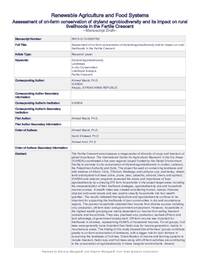Assessment of on-farm conservation of dryland agrobiodiversity and its impact on rural livelihoods in the Fertile Crescent

Authors:
The Fertile Crescent encompasses a mega-center of diversity of crops and livestock of global importance. The
International Center for Agricultural Research in the Dry Areas (ICARDA) coordinated a 5-year regional project
funded by the Global Environment Facility to promote in situ conservation of dryland agrobiodiversity in Jordan,
Lebanon, the Palestinian Authority and Syria. The project focused on conserving landraces and wild relatives of Allium,
Vicia, Trifolium, Medicago and Lathyrus spp. and barley, wheat, lentil and dryland fruit trees (olive, prune, pear,
pistachio, almond, cherry and apricot). ICARDA and national programs assessed the status and importance of local
agrobiodiversity by surveying 570 farm households in the project target areas including the characterization of their
livelihood strategies, agrobiodiversity use and household income sources. A wealth index was created considering
human, natural, financial, physical and social assets and was used to classify households into four wealth quartiles. The
results indicated that agriculture and agrobiodiversity continue to be important for supporting the livelihoods of poor
communities in dry and mountainous regions. The poorest households obtained their income from diverse sources
including crop production, off-farm labor and government employment. However, households in the highest wealth
grouping are mainly dependent on income from selling livestock products and live animals. They also practiced crop
production, worked off-farm and took advantage of government employment. Off-farm income was important for
livelihoods in all areas, representing 43–68% of household incomes. For all groups, fruit trees were generally more
important than field crops for income generation, mainly in mountainous areas. The finding of this study showed that all
farmers’ groups contribute greatly to on-farm conservation of landraces, with a bigger role for poor farmers in
conserving the landraces of fruit trees. Diversification of income and farming systems to include livestock, field crops and
fruit trees along with off-farm activities are contributing to the conservation of agrobiodiversity in these marginal
environments. Several opportunities for income increase and diversification through add-value activities and alternative
sources of income are demonstrated to the custodians of dryland agrobiodiversity. Their benefits can contribute to the
sustainability of agrobiodiversity conservation, provided that marketing of local products can be enhanced.
